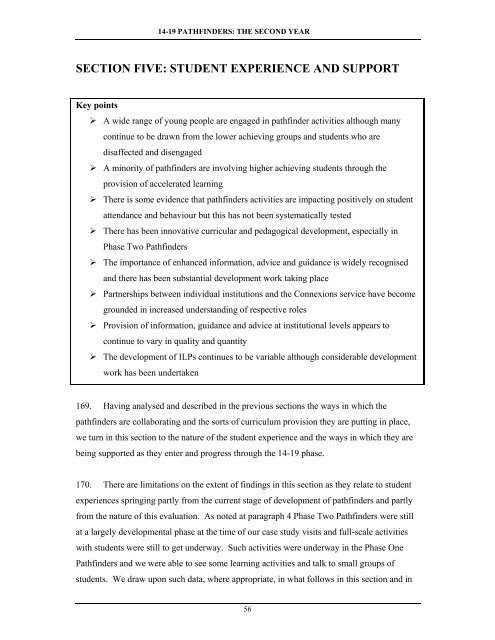Collaborative Approaches to 14-19 Provision - Communities and ...
Collaborative Approaches to 14-19 Provision - Communities and ...
Collaborative Approaches to 14-19 Provision - Communities and ...
- No tags were found...
Create successful ePaper yourself
Turn your PDF publications into a flip-book with our unique Google optimized e-Paper software.
<strong>14</strong>-<strong>19</strong> PATHFINDERS: THE SECOND YEARSECTION FIVE: STUDENT EXPERIENCE AND SUPPORTKey points‣ A wide range of young people are engaged in pathfinder activities although manycontinue <strong>to</strong> be drawn from the lower achieving groups <strong>and</strong> students who aredisaffected <strong>and</strong> disengaged‣ A minority of pathfinders are involving higher achieving students through theprovision of accelerated learning‣ There is some evidence that pathfinders activities are impacting positively on studentattendance <strong>and</strong> behaviour but this has not been systematically tested‣ There has been innovative curricular <strong>and</strong> pedagogical development, especially inPhase Two Pathfinders‣ The importance of enhanced information, advice <strong>and</strong> guidance is widely recognised<strong>and</strong> there has been substantial development work taking place‣ Partnerships between individual institutions <strong>and</strong> the Connexions service have becomegrounded in increased underst<strong>and</strong>ing of respective roles‣ <strong>Provision</strong> of information, guidance <strong>and</strong> advice at institutional levels appears <strong>to</strong>continue <strong>to</strong> vary in quality <strong>and</strong> quantity‣ The development of ILPs continues <strong>to</strong> be variable although considerable developmentwork has been undertaken169. Having analysed <strong>and</strong> described in the previous sections the ways in which thepathfinders are collaborating <strong>and</strong> the sorts of curriculum provision they are putting in place,we turn in this section <strong>to</strong> the nature of the student experience <strong>and</strong> the ways in which they arebeing supported as they enter <strong>and</strong> progress through the <strong>14</strong>-<strong>19</strong> phase.170. There are limitations on the extent of findings in this section as they relate <strong>to</strong> studentexperiences springing partly from the current stage of development of pathfinders <strong>and</strong> partlyfrom the nature of this evaluation. As noted at paragraph 4 Phase Two Pathfinders were stillat a largely developmental phase at the time of our case study visits <strong>and</strong> full-scale activitieswith students were still <strong>to</strong> get underway. Such activities were underway in the Phase OnePathfinders <strong>and</strong> we were able <strong>to</strong> see some learning activities <strong>and</strong> talk <strong>to</strong> small groups ofstudents. We draw upon such data, where appropriate, in what follows in this section <strong>and</strong> in56
















